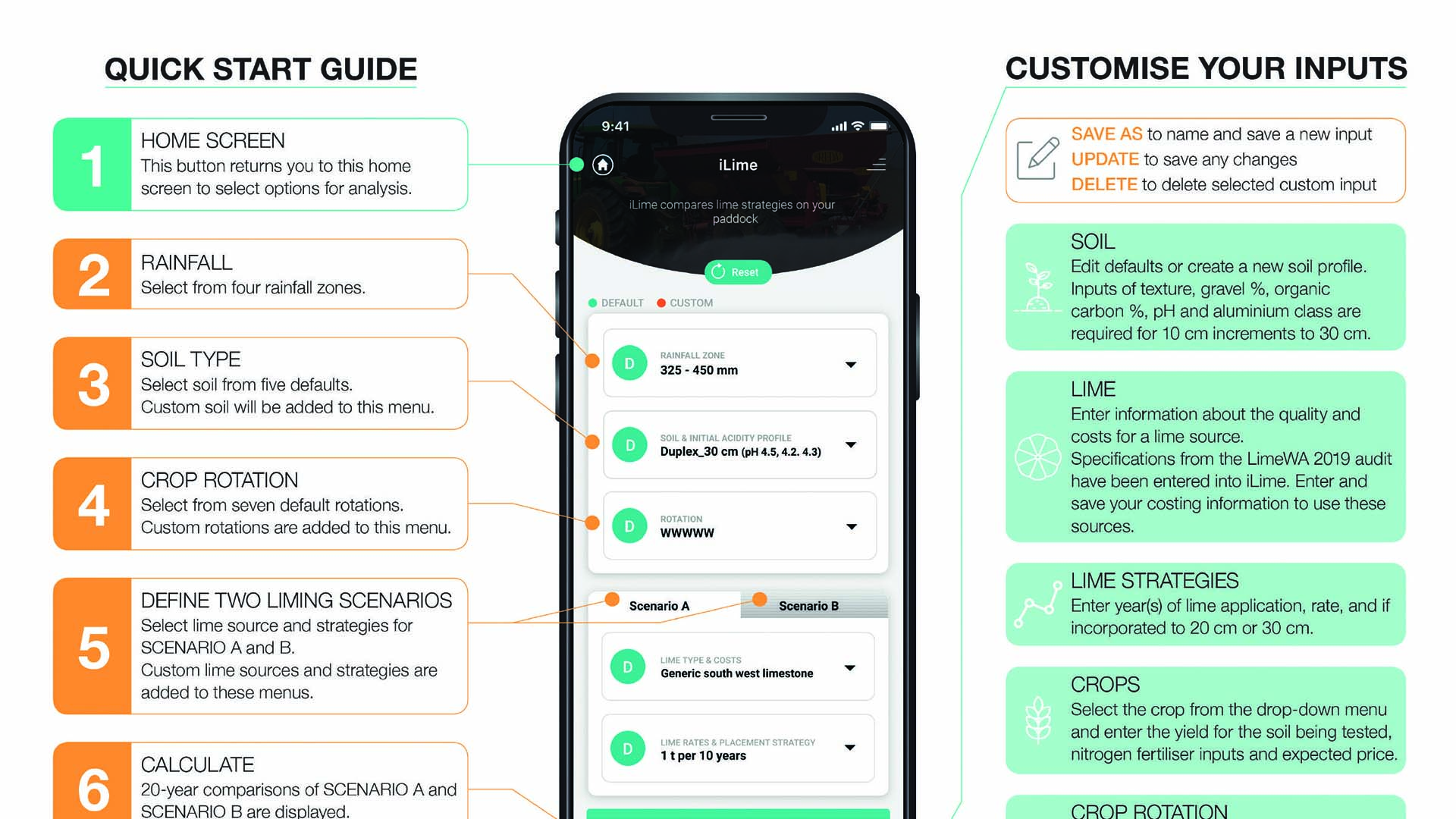Key points
- iLime app, designed with user input, can be customised to circumstances
- Yield response, pH changes and cumulative cash flow comparisons included in iLime output
- iLime has been validated with more than 10 years of data.
Estimating the impact of lime applications on soil pH, yield and profitability is now a lot easier.
A new app called 'iLime' enables users to compare two liming strategies against not liming, in just six 'clicks'.

Figure 1: iLime mobile interface described. Source: DPIRD
Mobile ease
The app, developed by the Department of Primary Industries and Regional Development (DPIRD), with co-investment by GRDC, uses inputs selected by the user to determine the change in pH and toxic aluminium in each of three soil layers and hence the impact on yield of crops and pastures (Figure 1).
Two liming scenarios may be evaluated and compared with a non-limed default. The app provides some initial lime, crop and soil parameters, but users can specify and save inputs to suit their circumstances.
Outputs include yield response, pH change in the top 30 centimetres and cumulative cashflow comparing liming strategies over 20 years.
DPIRD's iLime app, developed with @theGRDC coinvestment, just launched at the @DowerinFieldDay iLime will assist grain growers to identify the most profitable liming strategy for their property. https://t.co/rLFmeVSwze@GGA_WA@WAFarmers@WAPastoralists@GrainIndustryWApic.twitter.com/vxdLcWbocl
— DPIRD (@DPIRDWA) August 28, 2019
The iLime app may be used by growers and advisers to:
- compare lime sources and rates;
- evaluate economics of liming;
- prioritise paddocks for lime;
- investigate deeper liming;
- determine when to re-lime; and
- assess rotational options.
Feedback from growers and consultants pointed to the need for a mobile app to aid planning of lime applications. Such an app needed to estimate responses to managing soil acidity with lime in an easy-to-use interface.
The iLime app was developed over three drafts, with feedback to ensure that what has been produced will be of use and valued by the target audience of growers and consultants (as well as researchers and students).
Evaluation undertaken
Potential users completed a survey on the app's functionality at 15 field days where it was demonstrated.
Eighty-four per cent of respondents to a questionnaire rated the iLime app as easy or moderately easy to use (29 per cent easy, 55 per cent moderately easy).
iLime is a new mobile app that can be customised to assist growers with their liming decisions.
Respondents said they expected to use the app to compare lime sources (24 per cent), evaluate economics (27 per cent), investigate deeper placement (12 per cent), prioritise paddocks to lime (12 per cent), determine when to re-lime (16 per cent), assess rotational options (5 per cent) or to raise grower awareness (1 per cent). Multiple responses were allowed for this question.
Within a month of the app's release in August 2019, it had been installed by 402 users.
iLime complements the Optlime spreadsheet model that was developed as part of the 'Time to Lime' research program, which ran from 1996 to 2001 and was thoroughly reviewed in 2008. The app has been further tested using data collected over the past 10 years.
iLime fills a long-needed gap in the industry for an easy-to-use tool to evaluate the impact of lime applications on soil pH and economic responses.
The app may be downloaded from the App Store or Google Play as a free download and it works offline once it has been installed on mobile devices.
More information: email iLime@dpird.wa.gov.au or view AGRIC's iLime app.

























































